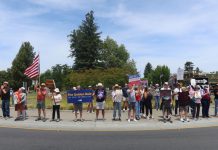The city of Healdsburg’s draft 2020 Urban Water Management Plan (UWMP) is still a work in progress.
The sentiment was echoed by community members and city council members during a recent council workshop and review of the plan where people expressed concern that the plan is a bit too broad and doesn’t adequately consider climate change in its analysis.
There were also concerns centered around the data points used to inform the plan, especially water usage data, which is not segregated into single family home usage and multi family home usage.
“What we’ve assembled is forecasted demand and supply for a 25-year period. This is a really high-level overview of the city’s supply and demand needs,” Healdsburg Utility Director Terry Crowley said during the virtual, Aug. 23 city council work session.
The outlook for Healdsburg’s forecasted demand and supply levels doesn’t look too sunny. If there’s a single dry year the city may find itself in a position similar to what we’re experiencing now and considering population growth, by 2045, water supply would not meet demands particularly during the drier years.
The team who put together the draft plan included Crowley, Healdsburg utilities engineering manager Patrick Fuss; Healdsburg water and wastewater operations superintendent Rob Scates; and Healdsburg utility conservation analyst Felicia Smith.
The components of the plan include a water demand analysis, baseline data for per capita use and water use targets, a water supply analysis, supply and demand comparison, water shortage contingency and drought planning and demand management and conservation details.
The UWMP is required per the state water code for agencies with 3,000 connections or for agencies that serve more than 3,000 acre-feet annually and the plan needs to be updated every five years.
There isn’t a formal penalty for not completing a UWMP, however, an agency or municipality that doesn’t complete one may not receive grant opportunities for water infrastructure projects.
Elements of the UWMP
Where the city gets its water
According to Felicia Smith, there are seven finished water reservoirs, one raw water reservoir and three well fields that the city can draw from, Gauntlet, Fitch and Dry Creek.
80% of the city’s water supply is sourced from the Russian River which is fed by Lake Mendocino. About 20% of the city’s water supply is sourced from Dry Creek which is fed from Lake Sonoma.
Forecasting population growth
A big aspect of the plan is forecasting population growth in order to forecast water demand. Population growth has been relatively flat over the past decade, but the 2020 UWMP assumes rapid growth of 3% between 2020 and 2030 and then a 1% growth afterwards.
Looking at historic rainfall levels
Smith said in looking at rainfall from 1911 to 2020 from a climate change lens, the averages tend to remain the same but the fluctuations vary quite a bit. There are some extremely wet years and then extremely dry years, the weather extremes of climate change.
To account for this expected continued variation, the city will need to consider multi-season storage or water supply sources not dependent on single season rainfall, according to Smith.
Considering climate change
Smith said when considering climate change some of the key takeaways to keep in mind is when the city experiences drought years water demand will increase for outdoor irrigation. Water quality is also something to keep in mind as drought years can lead to inconsistent stream flows, which can affect water quality.
Supply and demand projections
Fuss said over the past decade, residential water use dropped during the drought and later recovered. Future usage assumes accelerated growth of 3% and no conservation measures.
According to the city’s demand projections, by 2030 residential water use should increase to over 800 million gallons (MG) and commercial use is expected to rise to 100 MG. By the next decade, residential water use is expected to increase to almost 900 MG and in 2045, to almost 1,000 MG.
“The driver for our growth is residential and there’s 3% growth for the first 10 years. The other factors, commercial, industrial, landscape, those are increased at 1%, so you can see that we’re starting out at 492 for 2025 in residential and it zooms up to 662 by 2045, which is our entire usage for our base year of 2020,” Fuss explained.
Councilmember Skylaer Palacios asked why multifamily water usage data was not included as a separate data point.
Fuss said data is mined out of the utility statistics reports and the multifamily data is not tracked separately. The multifamily data is included with the single family and is not differentiated, according to Fuss. He said they could do it separately, but it’s an extremely laborious task.
“Generally, there’s a higher percentage of Latinos living in multifamily housing in our city and they generally don’t get the same amount of rebates but are also generally more likely using water less. They’re conserving more and it’s not really being noticed or rewarded in any way so that is a concern of mine. I’d definitely like to see a data point on that in the future report,” Palacios said.
Councilmember Ariel Kelley echoed Palacios’s statement about wanting to see disaggregated residential data.
In a normal year all water rights are available, Gauntlett, Fitch, Dry Creek, the Fitch Mountain water right and the Sonoma Water contract, which is only used when needed and when other water rights are not available. Dry Creek is only a seasonal water right from May to November.
The annual water right MG per year is 2,119. In a normal rain year, supply will be higher than the demand.
Looking at a single dry year supply versus multiple dry years
For a single dry year where all of the city’s water rights are curtailed — the city’s current situation — and there are only public health and safety diversions, the anticipated available volume in MG per year for 2025 is 576. It is 665 MG for 2030 and 733 MG for 2040, when the population is estimated to reach 17,517.
According to Fuss, in 2045 water supply would not meet demands particularly during the drier years and there would have to be a 45% reduction in water usage. For multiple dry years, summertime usage reductions would range between 20 and 37%, but the use of recycled water would reduce the annual water demand by roughly 40 MG after 2030.
Exploring future water supply options
There are several potential water supply options that the city can explore. These include tapping into aquifers and drilling wells for groundwater storage, establishing a recycled water pipeline, obtaining a year-round water right for Dry Creek, purchasing water and conservation.
“If the city were to be able to develop groundwater wells, those wells would supply water to the city. It would also allow the city to store water in the winter months that can be later drawn upon in the summer months or in dry years. We’re putting together a request for proposals for consultants to study this and we are looking at potentially constructing three groundwater wells within the city limits to help improve our water supply,” Crowley said.
He said this is a long term project that’s expected to take several years to complete. He said for this UWMP they’ve assumed that water from these wells will not be available until 2030.
Regarding recycled water pipelines (also known as purple pipes) Crowley said it technically isn’t a new water supply, but it would offset existing demand and free up water for other uses. He said the city is currently seeking funding for constructing a recycled water pipeline in the city limits.
Councilmember David Hagele, who has been a big proponent of the recycled water pipeline, said for him, one of the key parts of the plan is the consideration of implementing recycled pipeline infrastructure.
“The city continues to work on the year-round Dry Creek water right,” Crowley said. “This is a water right that was applied for in 1997. This would increase water rights from Dry Creek, which has a source from Lake Sonoma which has a multi-year supply of water versus Lake Mendocino.”
A year-round Dry Creek right would likely be one of the first rights curtailed during a drought. The right may help with supply in a normal year, but may not be as helpful during a dry year.
Crowley said conservation measures are the most important element across these forecasted years and are the most cost effective means to balance supply and demand.
Another option would be for the city to negotiate with Sonoma Water to purchase additional contract water that is stored within Lake Sonoma, however, this would come at a higher cost and would likely only be a short term solution.
Feedback on the draft
During the public comment portion of the Aug. 23 meeting, the draft received some constructive criticism regarding the plan’s feasibility, climate change consideration and its broad overview of the city’s water supply and demand.
“It seems to me an urban water management plan of success would look like not having to go to such high levels of conservation. Focus on the most drought proof solutions because reducing demand rather than keeping increasing supply only to have it cut off in dry years and in multiple dry years is just increasing system costs that puts a big burden on low-income rate payers. I think trying to reduce demand and investing in water conservation is probably the single best solution,” said Don McEnhill, the executive director of Russian Riverkeeper.
Healdsburg resident Tyra Benoit, one of the outspoken critics of the city’s 2015 UWMP, said the draft 2020 plan needs some work.
“I think in order to develop a more realistic planning tool we need to think about if we experience normal water years we’ll still have plenty of water, but that is not the reality. Patrick told us that over multiple dry years we would definitely be in trouble. We have to ask ourselves, what are the chances that a worse-case-scenario will happen? The sad fact is this, the plan still does not adequately explain what is understood about the climate crisis that we face. Here’s one of the quotes from the recent draft, ‘the average annual maximum temperature for this area is 73.5 and the average minimum temperature is 43.5. The average annual rainfall for the Ukiah Healdsburg vicinity is 37.26 based on numbers from 1893 to 2013. That data is old and needs to be updated. In the 2015 plan it was 41 inches of rainfall so that is a decline of four inches overall and shows a definite downward trend, yet that decline is not specifically noted.”
Benoit wondered why the plan only uses Ukiah rainfall data and said the average annual rainfall in the Santa Rosa area is 30 inches according to their urban water management plan.
She said some speculate Ukiah rainfall averages are used in the Healdsburg UWMP because it makes the rainfall data look better than it really is. She said that the plan should use data beyond 2013.
“That is a really gaping problem. We need to do better, we need to incorporate more about the impact of climate change and we need to work together to make this a better document,” Benoit said.
Resident Richard Burg expressed a similar view and said it doesn’t seem like the urban water management plan is really a plan, rather more of a snapshot of what they think is possible.
“I understand that it is made to appease certain requirements that the state has, but I think it is also good if it’s an exceptionally functional document for us to use and fall back on,” Palacios said.
She asked whether the document would discuss and include water hookup curtailments in the event of an extreme five-year drought.
Crowley said there are many questions about that and legal obligations that the city would have to consider really closely. He pointed out that there are also certain requirements to build affordable housing.
Palacios pointed out that her understanding is that some residents are advocating for a ban on water hook ups to non-essential development, not affordable housing.
“I guess I’m just concerned because when Patrick was presenting on the five-year drought there’s a plausibility that we would not meet the need of water during such a scenario and I guess the plan as it is is still a draft, but it doesn’t seem like there would be enough to aid the situation, so I’m just curious as to what other additional things we can think about putting into that part of the plan.”
Healdsburg City Manager Jeff Kay said city staff will take a look at this feedback, continue to process data, make revisions and bring the plan back to city council for consideration in the next two to three months.
To view the draft 2020 UWMP, click here.









